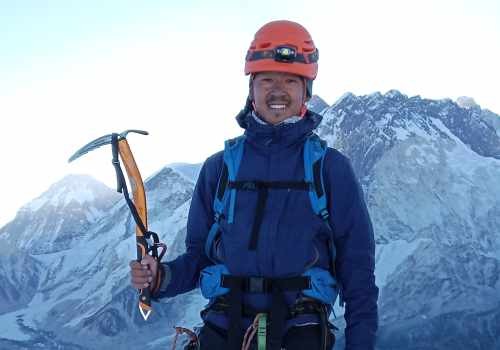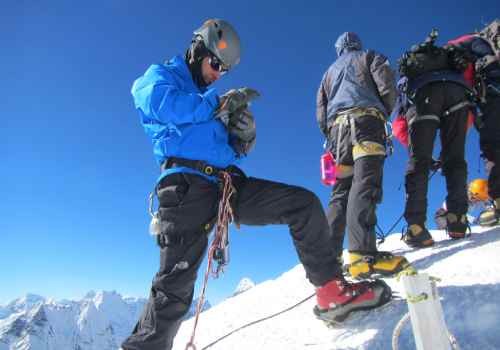‘great super adventure on one of highest trekking peaks of Nepal Himalaya’
Mera Peak is one of the most popular and the highest trekking peaks in Nepal.Mera Peak Climbing Adventure Trek takes you into the landscapes of mosaic ecosystems. Adorned with sheer wilderness it glorifies the hidden Hingku and Hongu valleys. It is extremely close to the Baruntse and Makalu mountain range within the Sagarmatha National Park.
Climbing Mera peak itself is not very technical and doesn't consist of a steep technical climb.But due to its high altitude range of 6461m at the summit invariably makes this a challenging climb for climbers around the world. Mera Peak is an amazing climbing experience that offers stunning mountain views, idyllic villages, forests, ancient culture, beautiful landscapes and many more.
Mera Peak climbing adventure trek comprises five of the world’s highest 8,000m mountains. It takes you off the beaten tracks that are very popular among trekkers for climbing.It is a perfect and an ideal peak for all interested trekkers and beginners for trying hands on mountaineering.
Mera Peak Climb is graded as ‘F’ means “Facial Easy” taken from popular French and Swiss Alpine Climbing Classification Systems. This grading is accepted world-wide whereas in the USA it equals 5.4 and 5.5 which means climbing on steep sections with large handholds. This means it is suitable for beginners with low angle to vertical terrain, basic to intermediate rock climbing skills required.
To scale it the climbers do require good climbing equipment.It involves crossing of high and difficult passes at times. Also if there is heavy snowfall or any kind of open maze of crevasses it will require a great deal of effort.Besides that all times our guides ensure that safety measures are adopted throughout the climb and trekking period.
Mera Peak Climbing Trail is the highest trekking adventure peak in Nepal that offers one of the best climbing experiences ever.All these trekking ingredients make it an exciting and challenging trip.
The beginning of Mera Peak Climbing Trekking Trip Adventure
Your extraordinary Mera Peak Climbing Journey begins with a lukla bound scenic flight. It takes you through to the forests, several cascading streams with an exploration of the wonderful valley.
The entire trekking trail is set on a rocked path that involves crossing rocky ridges. It consumes lots of energy hence traversing slowly with proper acclimatization, is important.
The trial continues to rise gently as you tread towards the Zatrwa La Pass into the Hingku valley. It is marked by mani and chortens all along the trail. Keeping to the same trail for a while you will then make a steep descend.
You will pass through to the dense forests until you reach to the snow fed river. From here you will then follow the lateral moraine of the Dig Glacier to Dig Kharka.
It is a wonderful place for spending an extra day at Kharka. Here you will be greeted by splendid peaks beautiful glacial lake. As this is one of the most enduring climbing peaks the climbing guide organizes training sessions.
You will be practicing skills, techniques, and exact way of handling crampons, rope, harness and ice axes etc. This short training will help boost your confidence levels before making it to the summit.
High in confidence the next morning you will then set out towards the high camp. Here you will get to explore glorious viewpoints that are quite dramatic. The panoramic sight of Everest, Makalu, Nuptse, Lhotse Baruntse and upto Mt. Kanchenjunga in the east direction is sensational. After spending quality time here you will descend back gently.
On the way you will get to notice and marvel at the breath-taking scenery of Amadablam, Kusum-Khanguru and Khangtiaga. The time flies as you walk and soon you will find yourself in Lukla.
At Lukla you will enjoy last night’s dinner with fellow trekkers, guides, and staff. A short celebration like atmosphere is created to relive the memories of a successful climb that you just had. Next day an early morning flight from Lukla will reach you back in Kathmandu.
Best season for Mera Peak Climbing Trekking Adventure
It is possible to climb Mera Peak all through the year. However there are two best times in a year for Mera Peak Trekking region they are autumn and Spring.
Autumn
The autumn months of September to November are by far one of the best times for climbing the Mera Peak. This is one of the safest, exciting, and a delightful time for trekking in Nepal.
From Mid-September to November the weather persistently remains stable, with no rainfall, or snowfall, and the temperature also gets warmer.Autumn is the safest season to enjoy any adventurous activity.
In the month of September you can see a few drops of rain here and there.The rainfall washes away all the pollution and dust around this peak. This allows you to enjoy the fresh air and perfect views.
Whereas October is the best month to climb Mera Peak because of the clear weather conditions, splendid views of the sunrise and sunset, and stable temperature.However at the tail end of winter the last few days of November are colder than other days of autumn. If you land in Nepal for trekking in November end then you need to carry some extra warm clothing to protect yourself from winter.
Spring
The spring months of March, April, May are the second best month for trekking in the Mera Peak Climbing Region. The weather remains stable and so does the temperature. It is warm enough for climbing.These months guarantee you with green vegetation and blossoming flowers that present fantastic views all around.
The first few weeks of March are colder because of the recent winter. So, make sure to pack warm clothing if you are planning your climb in early March.
Spring is the best month for Mera Peak Climbing. In these months there is no rainfall and snowfall. The days are brighter, which will make your climbing process easy and safe.In addition, you can get clear views of mountains and terrains.
If you are climbing the Mera Peak in late May then expect rain clouds because of the fast approaching monsoon. Hence you should come prepared with proper rain gears.
.jpg)


